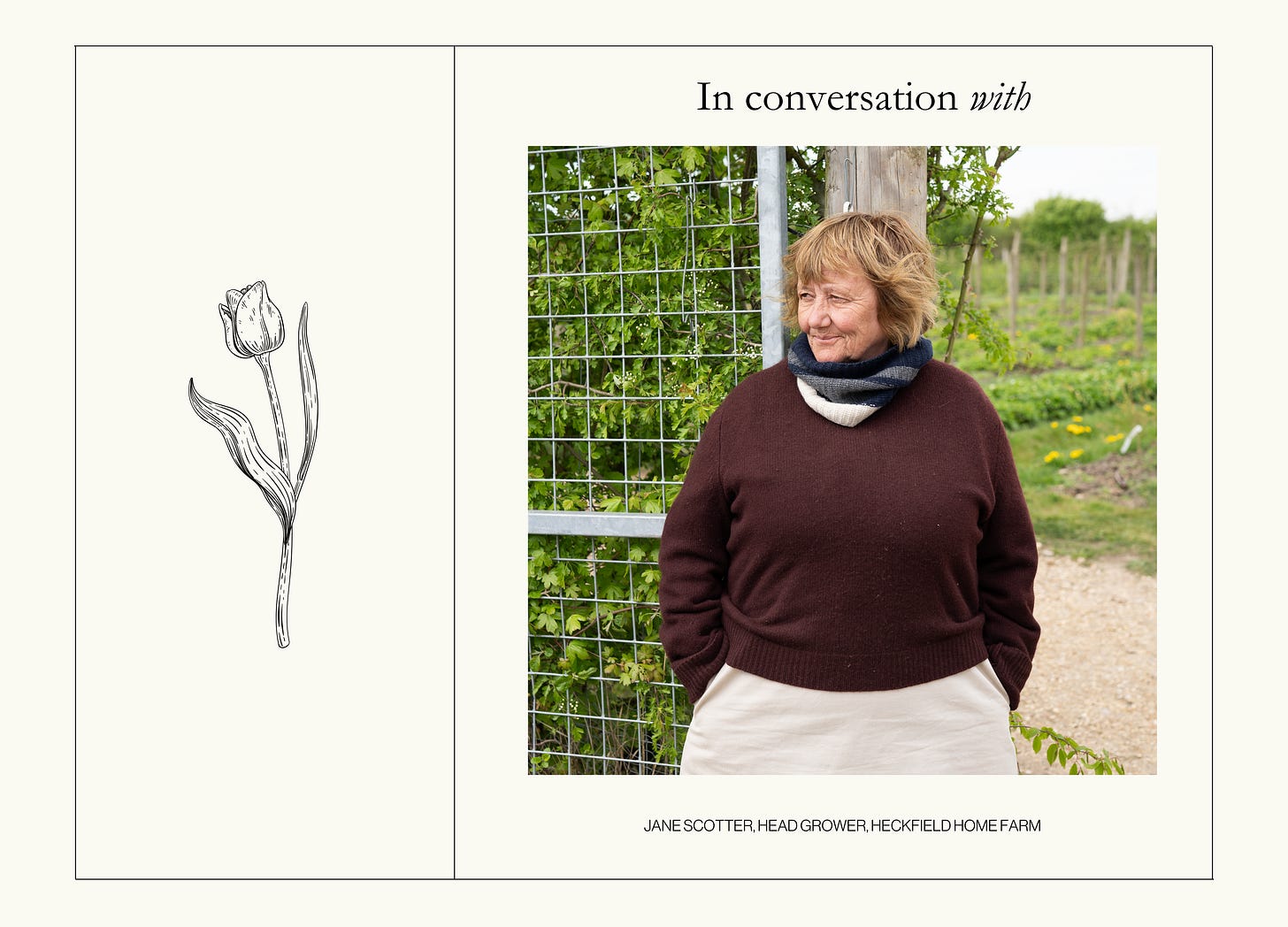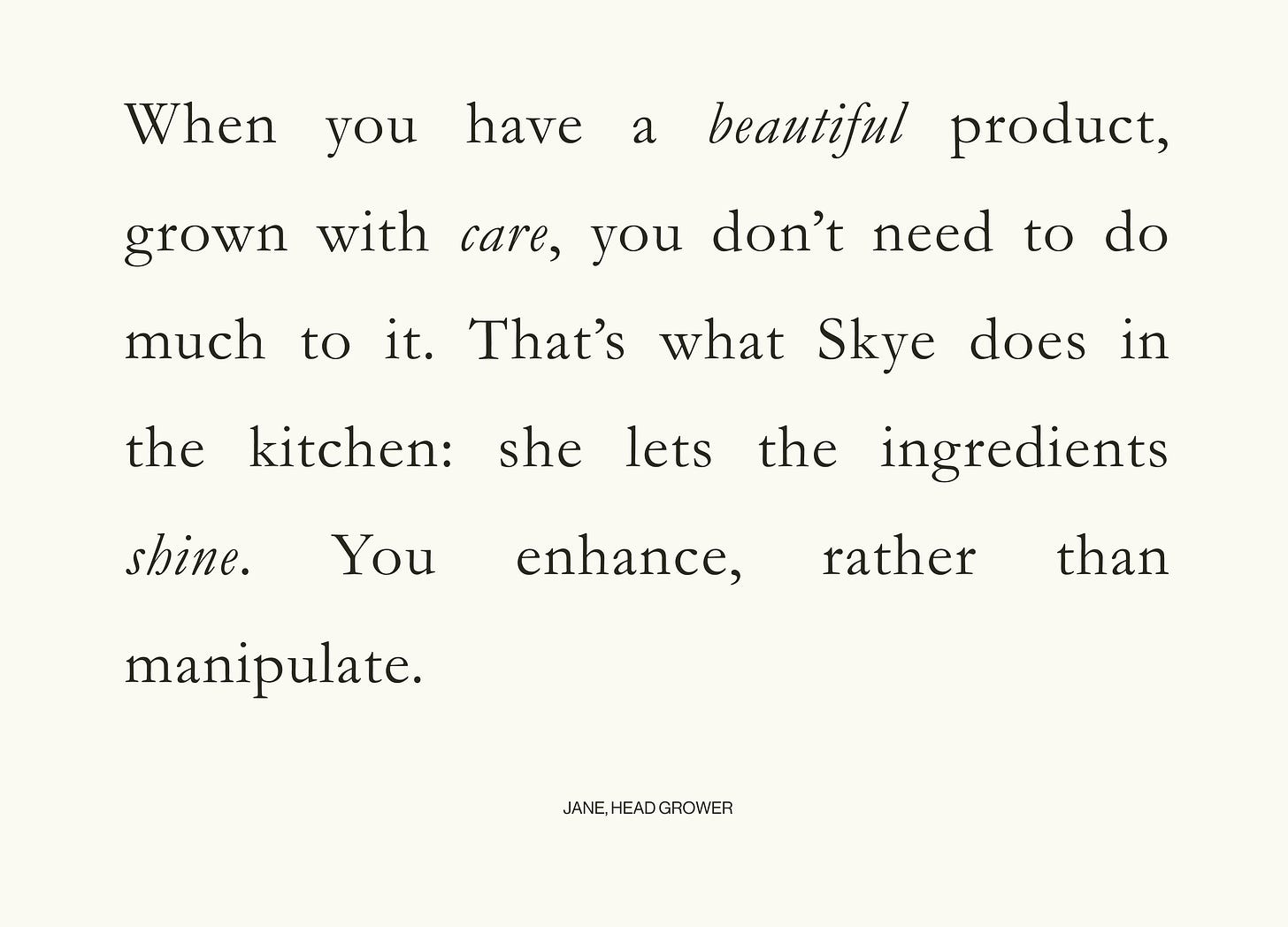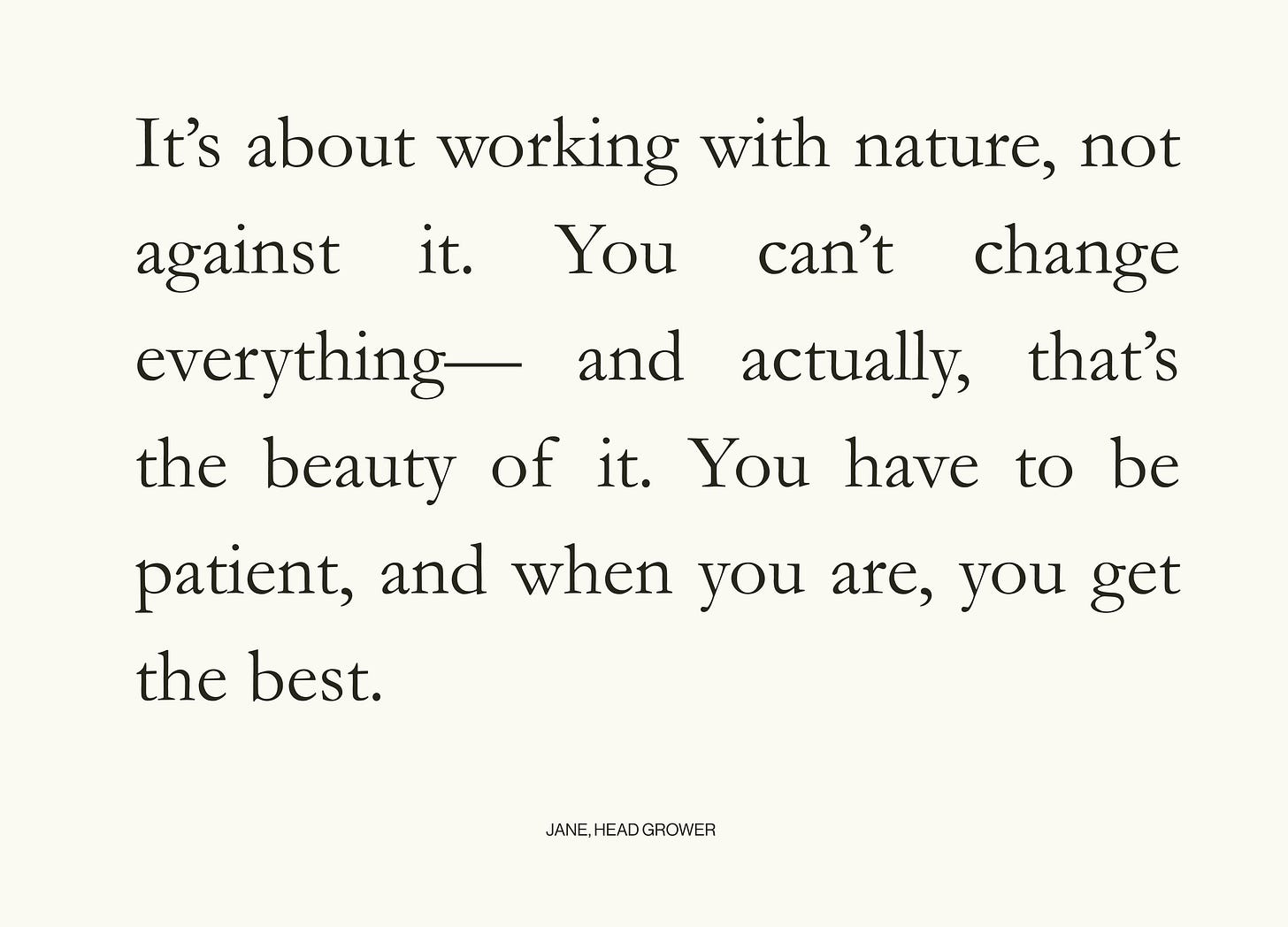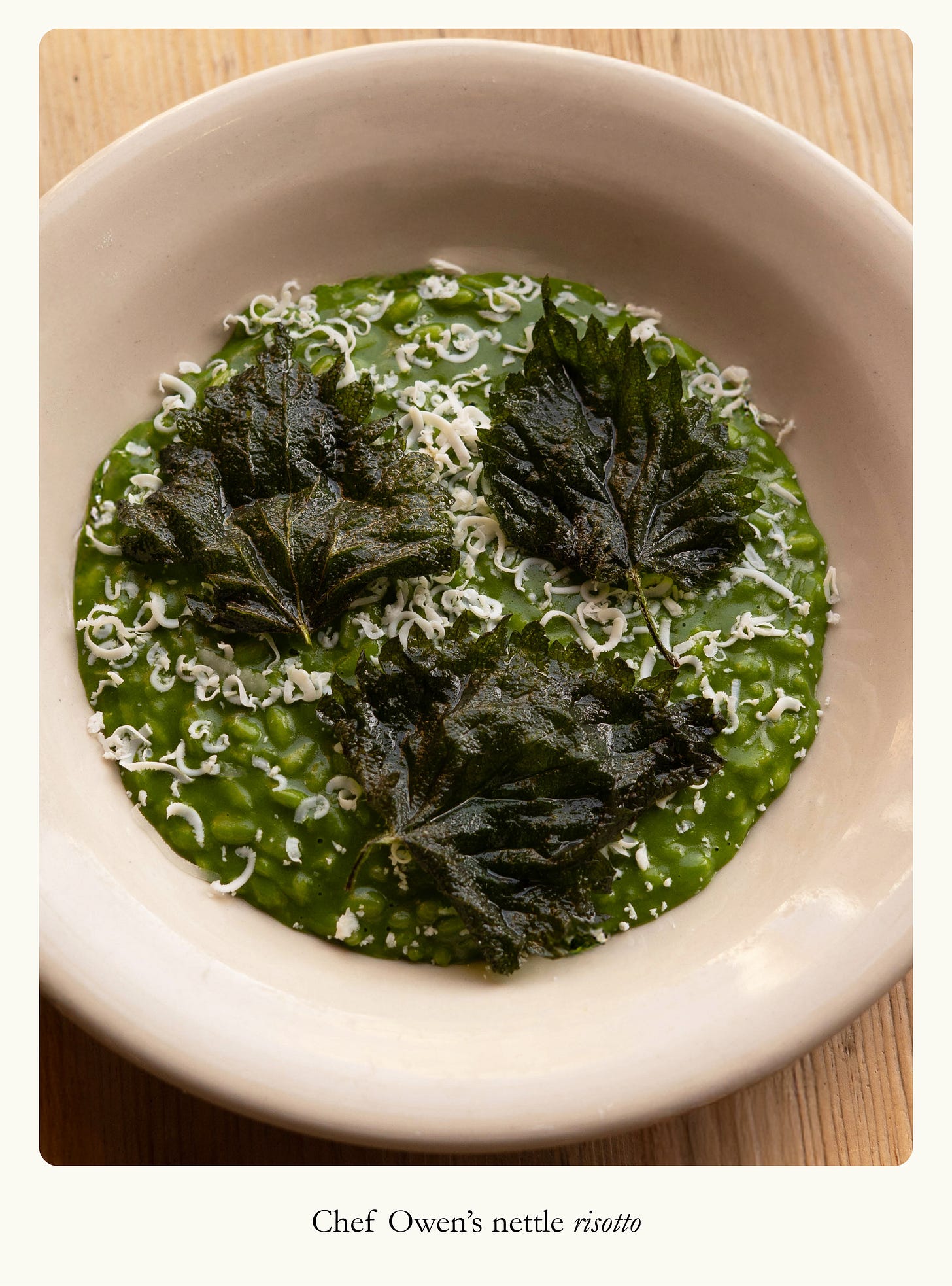A farmers’ market…with a guest list
A biodynamic market garden + a special guest chef recipe
Welcome to the second edition of A Good Table’s travel section. (If you missed the first, you can find it here.) This column grew from a desire to hold on to the quiet magic that travel offers—not through formal itineraries or must-see recommendations, but by tuning into the small, sensory details that make a place feel alive. The cool hush of a morning in a vineyard, the dusty scent of sun-warmed fruit at a market, the gentle calm of a hotel where time seems to pause.
At the heart of these beautiful places are the people — the cooks, growers, and keepers of land and story — whose hands and hearts shape the flavor and spirit of the place. With each edition, I’ll share a guest recipe or two, inviting you to bring a little of that world back to your own table.
This week, we visit Heckfield Home Farm — a quietly remarkable place, rooted in rhythm, soil, and season.
Once upon a time, the idea of sourcing local food and cooking with the seasons was seen as a whimsical pursuit—left to dreamers, barefoot idealists, and slow-food romantics. Now, in 2025, as we navigate an era defined by unprecedented challenges, this approach is no longer a fringe ideal but a cultural and environmental imperative we can no longer afford to ignore. Indeed, Farmers’ markets from Devon to Detroit are thriving, and words like biodynamic, regenerative, organic, and sustainable have entered everyday conversation. However, for all the buzz, farmers and growers still remain under-supported and under-represented by governments and institutions.
Tucked into the Hampshire countryside, Heckfield Home Farm is quietly doing the work. Each week’s produce sale isn’t just a market—it’s a celebration and preservation of the land’s rhythm. Leathery kale with morning dew still clinging to its curls, eggs so fresh their yolks seem lit from within, carrots pulled from the ground with the scent of the earth still on them. This isn’t just food—it’s a reminder of what we’ve been missing. Heckfield is cultivating more than crops; it’s cultivating care, community, and a deep respect for the soil and the seasons that shape our lives.
Heckfield Place is a contemporary country house hotel nestled within 400 acres of English landscape. The hotel is home to multiple restaurants led by Chef Skye Gyngell who is committed to the philosophy of sustainable, seasonal food. This is sourced at Heckfield Home Farm where everything is grown with a quiet devotion and patience that feels entirely authentic. Heckfield Home Farm is, indeed, the beating heart of Heckfield Place. Here the vegetables are impossibly fresh, and in summer, the flower fields erupt with sunflowers, roses and dahlias—riotous, delicate, defiant.
Each Saturday, the farm hosts a small, soul-stirring market. Some weeks there are lemon verbena plants, herbs and armfuls of flowers on offer. Other times, wooden trestles are piled with freshly-picked produce alongside fridges containing jars of condiments, bottles of creamy milk and stacks of cheese. Enough to furnish a picnic for sure, but if you prefer something warmer, an outdoor cafe offers delicious chef-made pastries, toasties and coffee. A wood-fired grill perfumes the air, turning out lamb koftas slicked with wild garlic aïoli, wrapped in pillowy pitas.
There’s no grand entrance, no velvet rope— this is a working farm, sweet with the scent of silage and alive with purpose. And still, it is achingly beautiful.
To enter, all you have to do is submit a name and an email prior to arriving, and you’re in. It’s free, and unpretentious. There’s nothing touristy or commercial about it. Members of the team are warm, impressively knowledgeable, and generous in the way people are when they’re rooted in purpose. When my husband mentioned our baby redwood wasn’t thriving, one of the growers handed us a bag of dried kelp and quietly shared instructions on how to nurse it back to health. A nursery indeed.
In today’s newsletter, we’ve got a guest recipe from Chef Owen Seamark, Head Chef at Hearth, one of Heckfield's restaurants, together with his thoughts on the best ingredients to experiment with this season, the most enduring kitchen advice he’s ever received, and how to truly cook in harmony with the land ( keep reading!)
I also spent time at the the end of April (before I headed back to California) with Jane Scotter - head grower, quiet force, and resident plant-whisperer of Heckfield Home Farm. Jane moves through the fields as though she’s in conversation with the plants. And maybe she is. There’s a rhythm here, a kind of clarity that only comes from deep listening - to the soil, the seasons, and the sky.
Pour yourself a glass of wine or brew a quiet cup of tea. What Jane has to say deserves your attention — this conversation stirred something in me, shifting my focus in unexpected ways. I hope it might do the same for you.
Sarah: Jane, can you share a little about your background, and what drew you to growing?
Jane: I’ve been growing for thirty years now. I started in 1996, when I moved to Fern Verrow from London - before that, I was a partner at Neal’s Yard Dairy, and before that, I cooked. So, food’s always been my thing.
I arrived at Fern Verrow with romantic ideas: living off the land, growing food, raising children. The reality was quite different, lots of hard work, every day - but overall it was a beautiful, rewarding journey. I taught myself how to grow well enough to make a living from it. Then, about ten, maybe fifteen years in, I met Skye Gyngell. She wanted to work directly with a farm in the way people were doing in the States - true farm-to-table. We had a very similar vision of food and land, and I started growing for Spring restaurant. That continues to this day.
Now, I’m mainly based at Heckfield Home Farm. I’ve been a consultant here for seven years, helped convert the market garden to biodynamic status, and am now Head Grower.
Sarah: That’s a beautiful journey. You mentioned the shared vision you have with Skye - how would you describe that vision? What drives you?
Jane: I think, at its core, it's about quality and beauty. I want the food I grow to be beautiful—visually, yes—but also in taste. That’s really what motivates me.
Skye’s the same. We care deeply about flavor. I can grow anything, but it has to taste really good. I don’t mind if it’s a bit quirky or has character—in fact, I prefer that. There’s also this shared belief in simplicity. When you have a beautiful product, grown with care, you don’t need to do much to it. That’s what Skye does in the kitchen: she lets things shine. You enhance, rather than manipulate.
That’s why growing outdoors, in season, is so important. I always say—if you're in the right environment, you thrive. The same goes for crops. Cabbages like it cool and damp, so when they get those conditions, they do really well. Try growing them in the heat of summer, and they just don’t taste the same. They struggle.
It’s about working with nature, not against it. You can’t change everything—and actually, that’s the beauty of it. You have to be patient, and when you are, you get the best.
Sarah: Your philosophy of simplicity really resonates. As a cook, especially in the age of social media and constant content, it sometimes feels like we’re expected to reinvent the wheel every day. But in truth, there’s nothing better than peak-season asparagus with good butter and salt.
Jane: Exactly! You can’t beat that. And yes, there’s pressure in restaurants to always be doing something new, something clever—but paring things back is often the best way forward. Take lettuces, for example. There are so many varieties. Some prefer cooler weather, others love the heat. It’s just about knowing when to grow what—for the most flavour, the best texture…. the real deliciousness.
Sarah: “Pairing things back is often the best way to move forward’’ - I love that Jane. As we move into warmer months, what are you most looking forward to growing this summer? What are you working on at the moment?
Jane: We had a very mild, joyful solstice and a warm spring, so we’ve been able to get onto the land a bit earlier than usual. Though of course, the downside of a dry spring is that we’ve had to irrigate earlier too, especially for soft fruit.
Still, something always thrives—this year the tulips have been brilliant.
Right now, we’re at that transitional moment. I’m looking forward to clearing out all the winter crops from the polytunnels and planting tomatoes, aubergines, sweetcorn. But we’re also watching the weather carefully—will there be another frost? You never quite know. So we’re holding on, preparing for the best but ready for the worst.
But I love this point in the year. Seeing the fields fill up, starting over again. It’s the newness—it never gets old.
Sarah: I feel that in my kitchen too. That moment where everything looks a bit sad and spent, and you’re itching to reset.
Jane: Exactly! You look at it all and think, I can’t stand this any longer. I need it to be orderly again. It’s a cycle.
Sarah: In the past, you’ve spoken about striving to make Heckfield Home Farm one of the best biodynamic farms in the country. What does leadership mean to you in that context—how do you approach it day to day?
Jane: It’s changed over time. I’m not a young person anymore, and moving from Fern Verrow to Heckfield, I’ve found myself with a strong support system and a bigger team than I could ever have afforded before. That’s allowed me to think differently about leadership.
I’ve got people on my team with very different skill sets, and my approach has been to give them ownership of what they do. For example, I’ve got someone who’s brilliant at plant raising—she runs with that, and gets the recognition for it.
What I love is seeing people grow within the business, not just being told what to do. That’s what’s working for me now: mentoring, supporting, helping people progress. I love being able to say to senior management, this person was responsible for this. That’s where the joy is.
Sarah: That’s such a generous and effective way of leading—giving people the space to shine…
Jane: Yes, it’s about facilitating, really. Making the conditions right for people to thrive. I’m happy to be the one doing the spreadsheets and checking quality, making sure everyone’s happy. But the real magic is seeing the team buzzing with enthusiasm.
Sarah: And finally, for those of us inspired by your work but working on a much smaller scale—window boxes, back gardens, rented plots—how can we bring a bit of your approach home? What’s a good first step?
Jane: Don’t be afraid of it. People often think they have to get everything perfect before they start. But you don’t. Just begin.
Even in a window box, you can grow something beautiful and delicious. Start with what’s in season. Start small. Observe. Learn from the plants. Pay attention. And try to work with what your space and your conditions can support—rather than forcing something to happen.
Generally, if you plant a seed, it will grow. It’s about care. That’s really it.
Hearth head chef, Owen Seamark, shares his approach to cooking, how he collaborates with chef Skye Gyngell, and what makes his spring menu so special. We also dive into the beauty of seasonal produce and Owen’s philosophy on simplicity, seasonality, and respect for ingredients. Plus, a very special guest recipe from Owen to bring a little of Hearth’s magic to your kitchen.
Sarah: Owen, how did you approach developing the menu at Hearth? Was there a particular philosophy or mood you wanted to capture from the start?
Owen: Here at Heckfield, everything starts down at the farm with the amazing produce available from Jane and the team. As a chef, it’s so inspiring to walk around the grounds surrounded by incredible, biodynamic fruit and vegetables, see the lambs, cows, pigs, and chickens roaming freely around the fields, and taste the incredible dairy from our herd of Guernsey cattle.
From there, we have a simple responsibility: forget individual ego, and don’t lose the natural beauty of an ingredient by over-processing.
Sarah: What’s it like collaborating with Skye Gyngell— someone so deeply attuned to the seasons and the beauty of vegetables? How does that partnership shape your cooking?
Owen: Having the opportunity to work and collaborate with Skye has been one of the greatest privileges of my career to date. I challenge anyone to have a conversation with Skye about food and not leave feeling totally inspired. Very few chefs have as deep an understanding of seasonality and how to bring ingredients together so delicately on the plate. I can spend days working on a dish, tasting and adjusting, and in a one-minute conversation with Skye, without her seeing or tasting the dish, she can visualise that finishing touch that will completely elevate it. Working with someone with that kind of experience is invaluable for both my personal development as a chef, and in guiding Hearth to be the restaurant that it is today.
Sarah: Spring produce can be delicate, fleeting—even a little unruly. As a cook, how do you handle it? Any challenges you’ve learned to love?
Owen: You must be adaptable. In the pursuit of consistency, so many restaurants can become rigid and inflexible with strict recipes and sometimes unrealistic demands on suppliers, causing so much unnecessary waste. The job becomes about being able to replicate a recipe but lacks the deep understanding of the how and why you are cooking each vegetable in a certain way. There are so many variables to working with peak season vegetables and no two vegetables are the same. Early season wild garlic is tender and mild, perfect for pounding into pesto, while late April/May wild garlic is tougher with a more pungent flavor and requires a lot more cooking and love.
Sarah: For people cooking at home, what spring ingredients would you recommend working with right now?
Owen: I could write a huge list of amazing ingredients this time of year. The obvious standouts that you can’t go wrong with are asparagus, wild garlic, and even radish. But if you’re looking for those hidden gems that aren’t easily found at the supermarket, my recommendation would be nettles, as seen in my recipe below, and alexander, a wonderful, foraged vegetable with celery and parsley notes. Make sure to eat both the buds and the fresh green leaves. Beautiful just quickly poached in an emulsion of butter and water.
Sarah: What’s the best piece of cooking advice you’ve ever received?
Owen: Really, continuing the theme - cook seasonally! The best chef in the world can’t make an out-of-season tomato taste as good as a tomato in summer, picked straight off the vine after a few weeks of sunshine. Buy the best you can afford, in peak season, and don’t overcomplicate it—let the natural beauty shine through.
Sarah: 100% agree! Could you talk a little about the guest recipe?
Owen: I’ve gone with a nettle risotto as I think it ticks all the boxes I look for in a perfect spring dinner party dish. It gives the beautiful nourishment of perfect creamy risotto, with the bright green color of the nettles, whilst also being very achievable in the home kitchen. For me, the ultimate one-pot dish.
This nettle risotto celebrates the very best of the season’s natural ingredients. If you can’t find nettle leaves, the risotto is equally delicious with any tender greens, from wild garlic to soft herbs. It’s also fantastic with cavolo nero, spinach, or other spring time leaves.
Keep reading with a 7-day free trial
Subscribe to A Good Table to keep reading this post and get 7 days of free access to the full post archives.




















